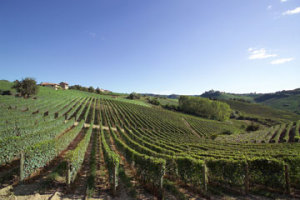While attending the Alba Wines Exhibition, I took the opportunity to visit Cantine Giacomo Ascheri, which quietly became a destination winery with the 2007 opening of a hotel and restaurant on-premise in Bra (the capital of the Roero area and the center of the Slow Food Movement). The winery’s location is an anomaly, stemming from a strategic business decision to move the winery from La Morra to Bra in 1880 in order to have better access to Torino, the most important market at the time.
Owned by Cristina Ascheri, the winery is under the direction of her son Mateo. They own three vineyards in Bra, Serralunga d’Alba and Verduno. In Bra they grow Viognier and Syrah. In Verduno and Serralunga they grow the indigenous Nebbiolo, Barbera and Dolcetto. They also buy grapes to make Gavi and Moscato d’Asti.
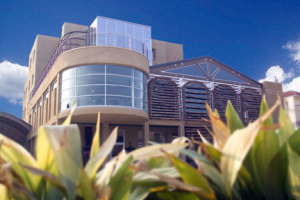
Albergo Ascheri
The hotel, Albergo Cantine Ascheri, is a thoroughly modern affair that sits atop the winery. There are 27 rooms, 4 junior suites and 2 full suites. From common areas you can look through the glass floor to the cellar below.
The casual restaurant, Osteria Murivecchi, is overseen by Mateo’s sister, Egi. Murivecchi means “old walls” and refers to the brick walls and vaulted brick ceilings of the room, which was once part of the old winery cellars. There is also an outdoor seating area under a pergola. The osteria serves traditional Piemontese dishes, paired with the local wines.
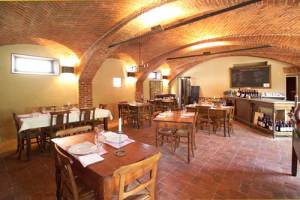
Osteria Murivecchi at Ascheri
I’ve been aware of Ascheri’s wines for the past decade, but this is the first opportunity I had to taste through the entire range, including a rare vertical tasting of Barolos from the Sorano vineyard in Serralunga d’Alba.
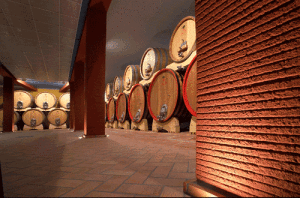
Ascheri winery
THE WINES:
The Whites
(all of the white wines are given the Cristina Ascheri designation):
CRISTINA ASCHERI, 2006, Langhe, ARNEIS:
Dry, full bodied as a Chardonnay with a creamy texture, flavors reminiscent of Golden Apples with some almond notes in the background, decent acid and a clean finish. Good wine to pair with white meats, fish and cheese sauces. 87
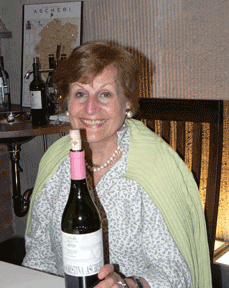
CRISTINA ASCHERI, 2006, GAVI:
Made from Cortese grapes grown in the Gavi area of Piedmont, this rendition is surprisingly full bodied. It’s an off-dry wine with good acidity and fine minerality to support the kiwi-honeydew melon flavors. It could work well enough with poultry, and equally well as an aperitif. 86
CRISTINA ASCHERI, 2004, Podere [farm] di Montalupa di Bra, Langhe, VIOGNIER:
It’s interesting to see how a grape responds to a particular terroir. Viognier in the Rhone is very different from Viognier in California’s Sierra Foothills, and this version from Italy’s Piedmont is again it’s own interpretation. The color is yellow (though it doesn’t come off as oxidized). The nose displays ripe pineapple and apricot. It’s a dry, full-bodied white that is best served chilled. It’s the perfect accompaniment to shrimp in white sauce, or the local vitello al tonno (veal with tuna sauce). 90
The Reds:
ASCHERI, 2004, Podere di Montalupa di Bra, Langhe, SYRAH:
When we first opened this wine it was dense, blocky and not altogether pleasant. However, with a little air it blossoms. The nose is rich and redolent of stewed plums, while the flavors point distinctly to strawberry and plum. Silky smooth with the tannins in check, this Syrah is an intensely fruity wine that can pair well with barbecue, teriyaki, or lasagna. 87
ASCHERI, 2006 Podere di Rivalta di La Morra-Verduno, Nirane vineyard, DOLCETTO D’ALBA:
As with most Piemontese wines, this one benefits greatly from airing, so I advise you to decant it prior to serving. Despite Dolcetto being relegated to the third tier of Piemontese reds, behind Nebbiolo and Barbera, it’s a fruity wine (blueberry or blackberry come pretty close) that can also show some depth of character. This one also has some complex roasted meat and fruit pie flavors, with mild tannins. 86
ASCHERI, 2005 Podere di Sorano, di Serralunga D’Alba, S. Rocco, DOLCETTO D’ALBA:
Loaded with typical blueberry flavors, well-balanced and easy to drink right now. Dolcetto is not meant for long aging, but it does benefit from three to five years in the bottle. As a side note, after first tasting this wine I set the rest of it aside for cooking. A week later, while cooking, I decided to taste it to see if it had turned to vinegar. To the contrary, it was still holding it’s own, though to be sure you wouldn’t gain much from extended ageing. 85
ASCHERI, 2005 Podere di Rivalta di La Morra-Verduno, Fontanelle vineyard, BARBERA D’ALBA:
Bright strawberry, rhubarb and plum aromas, tending toward tart red plums on the palate, light tannin, crisp acidity and a tart finish. 86
ASCHERI, 2001 Podere di Sorano, Coste & Bricco, Serralunga D’Alba, BAROLO:
From the same estate as the other Sorano Barolo, Coste & Bricco is a special selection from the vineyard that is only made in better years. It sees more new oak (40% as opposed to 15%). 2001 was an very good vintage and this is a great Barolo. Drinkable even now, it’s already showing great complexity and elegance — mineral, black truffles, rose petals, tart cherries. The tannin is evident, but soft. For the optimum experience, open 2010 – 2018. 92
ASCHERI 2004 NEBBIOLO D’ALBA:
What a lovely wine, showing the true face of Nebbiolo: rose petals and cherry with underlying mineral earthiness. Barolo will achieve these qualities with added texture and depth given several years in the bottle. But why wait? You have a good approximation of the varietal’s capabilities right now in a wine with fully integrated tannins and bright acidity. Lovely stuff! Drink now through 2012. 88
ASCHERI, 2003 Vigna dei Pola, La Morra – Verduno, BAROLO:
I’ve had this on two occasions now. One bottle showed more tannin than the other (or maybe my palate was off). In either case, it’s a very promising Barolo, serving up rich layers of cherry-plum fruit, white truffles, white pepper, cardamom, and wafting in from the background the lovely scent of red roses. The tannins in one bottle severely masked the fruit, while in the second the tannins were unobtrusive and didn’t interfere with the fruit, so you could enjoy it now with food. It should age very nicely over the next 3 to 5 years. 87
On my visit to the winery with fellow writer Kyle Phillips, we were also afforded a vertical tasting (same wine, different vintages) of the Sorano vineyard Barolo, grown in Serralunga d’Alba, next door to Fontanafredda.
ASCHERI, Podere di Sorano, Serralunga D’Alba BAROLO:
1996:
This is why we love Barolo — with enough time in the bottle it becomes a delicate, alluring wine with great complexity. Intense and aromatic of cherry, leather, mineral and truffle all in perfect balance. It’s vibrant, full of fruit and nuance. There’s also a hint of vanilla (though no barriques were used). This will be very long lived. 96
1997:
A very ripe wine form a warm year. The tannin has fallen away. There is a bit less truffle character and the cherry fruit gives a sweet impression (though it’s a dry wine). It’s a very fine Barolo, but it doesn’t have the energy, nor complexity of the ’96, nor will it age as long. Drink now through 2015. 92
1998:
Very similar to the 1996, though earthier. The tannin is almost resolved. The fruit is more subdued than the ’96, but it’s still vibrant and rich, and a fine level of minerality runs through the mid-palate and carries the finish. Very fine balance and acidity. This wine will age very well. 93
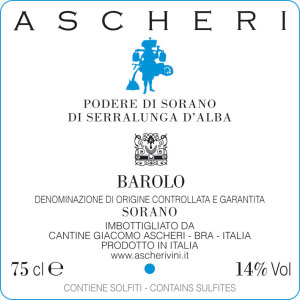
1999:
Ripe red plums and rose petals vie with complex earthy aromas and flavors (cippolini mushrooms and truffles). The texture is already silky and will only become silkier as the tannin drops away. Lovely finish. The tannins are almost resolved, yet the ’99 will continue to evolve over the next decade and more. 94
2000:
This was a warm harvest. It’s a dense, plummy wine, showing less depth than the ’96, ’98 and ’99, yet with some airing it does pull a touch of licorice and a hint of earthiness to come. With the tannins still a bit coarse, this is a baby; it just needs time to mature. 89
2001:
An elegant wine with candied cherry and light floral aromas, a hint of basil and mineral undertones. Kyle Phillips thought it showed some balsamic flavors. The tannins are beginning to resolve and already showing some of the delicate nature of Nebbiolo. It would be best appreciated for current drinking if you decant it first. However, it will take years to reach its full potential, so if you have the patience, wait to enjoy from 2012 to 2020. 88
2002:
No wine was made from the disastrous 2002 vintage.
2003:
Surprisingly approachable for just 4 years after the vintage. Like the 2001 it shows candied cherry fruit over tarry-earthy notes and a hint of cut flowers. The tannins are still a bit puckery, but should be mostly resolved by 2010 – 2011. 86
Albergo Cantine Ascheri
Via Piumati, 25
12042 Bra (Cn)
Tel. +39 0172 430312
Fax +39 0172 418776
albergo@ascherivini.it
Cantine Ascheri Giacomo
Via Piumati, 23
12042 Bra (Cn)
Tel. +39 0172 412394
Fax +39 0172 432021
ascheri@ascherivini.it
Osteria Murivecchi
Via Piumati, 19
12042 Bra (Cn)
Tel. +39 0172 431008
Fax +39 0172 432021
osteria@ascherivini.it
& & &

